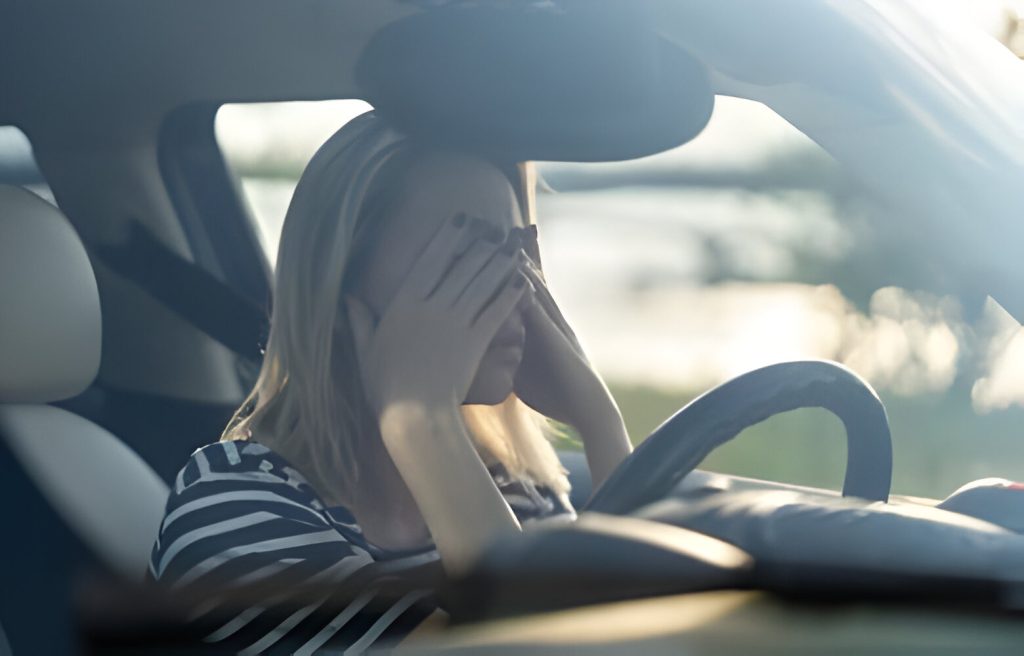- KNOWLEDGE BASE
- EATING DISORDERS
- General Topics
- No posts found for the specified taxonomy and term.
- General Topics
- EATING DISORDERS

SWISS MEDICAL EXPERTISE: ZURICH, MALLORCA, LONDON, MARBELLA


CONDITIONS WE TREAT
PROGRAMS
Intensive residential treatment program starting from 4 weeks. Location: Mallorca, Zurich, London.
Comprehensive second opinion assessments for both psychiatric and general health concerns. Location: Mallorca, Zurich, London
ADDITIONAL INFORMATION





11 Minutes
CONTENTS
Driving, an absolutely normal part of adulthood, is often considered a symbol of independence. It gives you the means to cover large distances with full autonomy, but it can also be anxiety-provoking, especially on highways or during rush hours.
For some people, this seemingly normal activity can become a harrowing experience, going way beyond normal anxiety and ultimately ending in a full-fledged panic attack.
The idea of having panic attacks while driving can make even the easiest commute the most daunting challenge of your life. The tightening grip of anxiety and the fear of losing control over your vehicle can make you battle with your mind for survival.
If you are among the one-quarter of drivers who are prone to extreme anxiety and panic attacks during driving, do not worry! [1] Understanding the issue and its causes can help you prevent a panic attack in a car in the future.
Wondering what’s causing you to experience panic attacks as soon as you get behind the wheel? Let’s explore some common causes:
Panic Disorder is classified as an anxiety disorder that causes individuals to suffer from regular sudden panic attacks with no apparent trigger. [2] This means these individuals can get an attack at any time, including when they are driving.
It is common for people with an underlying panic disorder to experience ongoing fear and anxiety about having another panic attack. This excessive worry itself plays a precipitating role in triggering another panic attack.
Sometimes, driving can lead to various sensations and pains that become a trigger for panic attacks. It is particularly true for people with panic disorder who are overly sensitive to how their body feels. So if such people sense any light pains, leg weakness, or elevated heart rate, they may develop a panic attack
A lot of people are anxious when it comes to driving which increases their possibility of getting a panic attack. Anxious drivers worry about driving long distances, using unknown routes, going above a certain speed, being shouted at by other drivers, or driving in bad weather. Whatever trigger is present, it may increase their level of anxiety, potentially leading to a panic attack.
Some people can experience panic attacks triggered by underlying phobias. For instance, if you have a phobia of tunnels or bridges, crossing them in your car may make you anxious, triggering a panic attack.
You are more likely to get panic attacks while driving if you have a history of car accidents, especially when the accident caused severe damage to the vehicle or the driver. In such circumstances, driving may trigger symptoms of posttraumatic stress disorder, making you believe that you will get into another accident, and ultimately pushing you into a panic attack. [3]
Stress is the primary precipitant of panic attacks. Hence, the risk of these attacks automatically increases if you encounter a stressful situation before starting your car journey. These stressful situations can be related to relationships, work, or academics.
Many factors can make you hyperventilate behind the wheel, such as your sitting position, seatbelt, or fear of driving. In people with anxiety, this hyperventilation can easily trigger a panic attack.
A history of abuse, anxiety, trauma, or another life stressor can put you in a state of long-term anxiety and stress. This ongoing stress makes you more vulnerable to experiencing panic attacks at any time, including while driving.
If you think you are experiencing a panic attack while driving or even when you are thinking of driving, look out for the following signs and symptoms: [4]
Remember that you do not need to experience all of the symptoms mentioned above to be struggling with a panic attack.
If you feel like these symptoms are showing up, pull over to the side and try focusing on your breathing to remain calm. Remind yourself that this attack is temporary and the symptoms should subside in a few minutes.
As frightening as they may seem, panic attacks are harmless and cannot cause any damage to the body in the long run. So why is it so important to manage them if they happen during driving?
Sudden panic attacks that occur while you are driving always carry a risk of making you commit mistakes. For instance, you may lose focus, swerve suddenly, or pull over to the side of the road without checking road clearance which can have dangerous consequences for you and other drivers. [5]
Panic attacks can be extremely distressing, particularly when they occur while you are behind the wheel. If you already have a diagnosis of an anxiety disorder or panic disorder, these frequent attacks can worsen their symptoms, inducing a detrimental effect on your overall mental well-being.
Panic attacks while driving can make you an overly cautious driver. While this attitude may feel safer, it can put you at a greater risk on the road.
For instance, you may slow down excessively before turning a corner or drive significantly below the speed limit which can lead to a collision. Moreover, slow driving can distract you more easily, which also increases the risk of accidents. [6]
Sometimes, you feel so terrified of having another panic attack behind the wheel that you stop driving altogether. This can negatively affect your professional and social life while increasing your fear of driving.
If you frequently experience panic attacks while driving, learning how to manage them is imperative to stop them from worsening. Fortunately, getting these attacks under control with the right support and techniques is possible.
While many people seek help from a therapy program, many self-care tips can also prove useful in managing panic attacks while driving.
If you are in the middle of the road and start experiencing a panic attack, the first thing to do is decide what you wish to do immediately. If you feel like the symptoms of the ongoing attack are severe enough to impair your ability to drive safely, pull over to the side of the road and wait for the symptoms to subside.
Alternatively, if you do not see a safe place to pull over, continue driving while ensuring safety for everyone. Consider trying any coping strategies you may have learned to reduce the symptoms in the meantime.
One of the benefits of continuing driving during or after a panic attack is it gives you the confidence to confront your fears. Moreover, you can also use such incidents to convince yourself that you can manage your panic attacks well. Doing so will minimize, or possibly, prevent the recurrence of these attacks in the future.
What goes in your mind when you drive or think about driving? Do you worry a lot about getting into the worst-case scenario, like getting caught by a speed camera, crashing, or losing your way? If yes, these catastrophic thoughts are what’s triggering your panic attacks.
What you need to do is learn how to challenge these thoughts by recognizing their irrationality. Remind yourself that these thoughts are baseless and discard them before they lead to a panic attack in the car.
The next time you worry about driving, pause for a second and check: are you focusing too much on what will happen in the future?
Dwelling on all the bad things that can happen to you in the near or distant future can create unnecessary panic. Sometimes, it can signal your body to get ready for an expected danger, pushing it into a hyper-alert state for no reason.
Learn to live in the moment without worrying too much about the future to stop your panic attacks. Mindfulness is the best way to do so as it helps you focus on the present without worrying about the future.
The next time you feel anxious about driving, notice what you do to feel better. Some common mechanisms that people rely on to relieve driving-related anxieties include the following:
Remember that all behaviors mentioned above will only feed your anxiety and can raise the possibility of experiencing another panic attack in the future. Instead of relying on these fear-based behaviors, adopt healthier coping mechanisms, such as:
The strategies mentioned above are likely to get you out of the panic attack spiral without any negative consequences.
Panic attacks can be very stressful and may tempt you to rely on drugs or alcohol to cope. While substance use may provide temporary relief, it can potentially worsen your mental and physical health while increasing the risk of more panic attacks in the future. Driving under the influence can also make you more vulnerable to accidents. Hence, try to avoid them as much as you can and seek help to quit if you have already started using them.
If you feel like you have started experiencing panic attacks while driving more frequently, seeking professional help is the best way forward. Consider visiting your primary healthcare doctor or a mental health professional for an initial assessment and diagnosis. Based on their assessment, these professionals can direct you to the best available treatments.
Many therapeutic programs are currently available for people with driving anxieties and panic attacks. These programs take place in a safe space and give you a chance to work through your feelings and thoughts that trigger panic attacks.
Also known as ACT, acceptance and commitment therapy focuses on teaching how to accept anxious thoughts and let go of them so they do not affect your feelings. ACT also focuses on the dissipation of fear and worry through simple techniques. You can apply these techniques to stop your anxiousness before it intensifies into a panic attack.
Also known as CBT, cognitive behavioral therapy is a technique that teaches you how to identify, challenge, and replace negative thoughts to avoid panic attacks. It also helps you learn relaxation techniques and mindfulness to stop your anxious thoughts from getting out of control. [7]
This therapy exposes you to things that trigger panic attacks, such as driving, while teaching you various coping techniques to deal with such situations. The exposure takes place in a safe and controlled environment so that you do not feel overwhelmed and you get a chance to practice your coping skills in real time. [8]
Panic attacks during driving can have many causes. It may be because of an underlying panic disorder, a past trauma, generally high-stress levels, etc. If these panic attacks have started occurring more frequently, I suggest seeing a healthcare professional to find out the cause and manage it before you get into a risky situation.
Generally, panic attacks continue for 5 to 20 minutes, but sometimes, it may take longer. There is no way to find out the exact duration or predict when the next one will happen. Having prolonged panic attacks, lasting up to an hour, is not very common and if you experience them, I suggest consulting a mental health professional.
I do not recommend quitting driving because it provokes panic attacks as doing so will only reinforce the anxieties that led to these attacks in the first place. What this means is you will become more vulnerable to more panic attacks in the future, with possibly worsened symptoms. If you are not confident enough to drive again, take things slow and work your way up in terms of time and distance covered.
Certain medications are known to help ease the symptoms of a panic attack, even though they cannot treat the underlying cause. Some examples of these medications include benzodiazepines, serotonin-norepinephrine reuptake inhibitors (SNRIs), and selective serotonin reuptake inhibitors (SSRIs). Remember that benzodiazepines can be highly addictive so using them in the long run can be dangerous. I always suggest seeking advice from a mental health professional regarding the best choice of medicine.
My personal favorite way to tame a panic attack is through controlled breathing exercises. Stress during driving can fasten your breathing which causes hyperventilation and panic attacks. Whenever you feel like a panic attack is impending, slow down your breathing. My mantra is to inhale for 5 seconds, hold for 2-3 seconds, and exhale for 7 seconds. This 15-second-long breathing practice will prevent hyperventilation while improving the levels of carbon dioxide in the blood. Deeper breaths also reduce your heart rate, which favors the prevention of a panic attack.
COGNIFUL is a leading provider of luxury addiction and mental health treatment for affluent individuals and their families, offering a blend of innovative science and holistic methods with unparalleled individualised care.
We believe in the healing power of a community that brings together collective wisdom and individual insight from collective group sessions and activities. We offer a variety of activities and therapies, from group workshops to communal living experiences, every aspect of our program is designed to foster growth, understanding, and self-improvement.
more infoOur program is uniquely designed to meet your needs, with our team closely monitoring your progress. Our therapists are committed to addressing the underlying causes of your challenges, not just the surface symptoms. This deep, root-level therapy extends beyond your stay with us, ensuring enduring success and well-being.
more infoOur team of specialists integrates the most effective strategies from psychological care and holistic medicine, offering you personalized support. This approach includes a range of complementary therapies, all seamlessly coordinated to work together in a comprehensive, integrative manner for your benefit.
more infoThroughout your stay, our dedicated team will ensure a personalized and nurturing experience, providing continuous support and attention. We are committed to guiding you through every step of this transformative journey.
more infoNestled in a serene location close to the calming embrace of the beach, our luxury residence is designed with healing in mind, featuring private suites that offer an oasis of tranquility. Each suite is crafted to provide a personal sanctuary where individuals can reflect, rejuvenate, and recover in peace.
more infoComplex trauma frequently underlies both mental and physical distress. We offer a secure environment, incorporating integrated trauma treatment techniques to facilitate the healing process.
more info